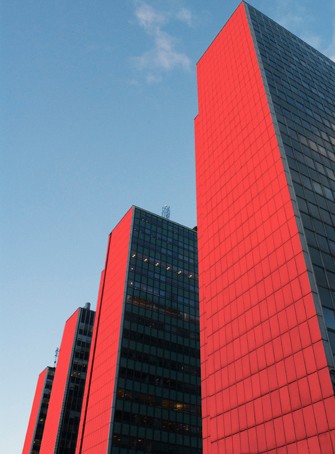
Erik Krikortz, Emotional Cities, 2007 Fotomontage: Åsa Lundén/Moderna Museet © Erik Krikortz
The 1st at Moderna: Erik Krikortz
Emotional Cities
1.11 2007 – 6.1 2008
Stockholm
Via www.emotionalcities.com everyone is welcome to record their current emotional state on a scale from one to seven smileys, from very unhappy to very happy. These emotional states correspond to a colour scale from violet to red, and influence the coloured lighting of the facades of the five Hötorget buildings in central Stockholm.
Erik Krikortz explores issues of democracy and public spaces. He pursues an established tradition in art of drawing attention to the shortcomings and merits of the city, with the use of new technology and its interactive potential. In Emotional Cities he takes the pulse of Stockholm. Or as Krikortz himself puts it:
Advertising dominates the public space, points at our shortcomings and tells us what we need in order to feel good. Our economy is an ‘economy of deficiency’, based entirely on dissatisfaction. Through this light installation, the city’s denizens can demonstrate collectively how they feel. The result is a psychological diagnosis of society.
Curator John Peter Nilsson associates the project with the Canadian philosopher Marshall McLuhan and his theories on the information society as an extension of man’s central nervous system:
McLuhan’s observations have become our everyday reality. Radio, TV, newspapers and the internet are not only carriers of information and knowledge – they also register and sometimes enhance private and collective emotional states. The media can be both deputy mourner and cheerleader for us in various events.
Erik Krikortz (born 1975 in Luleå) studied at the department of art at the University college of Art, Crafts and Design, Konstfack, in Stockholm. His projects are usually set in the public domain and on the internet, and require the participation of other people. In 2006, he won acclaim for the work Colour By Numbers, a collaboration between Krikortz, Loove Broms and Milo Lavén, where the ten top stories of the former LM Ericsson telecom tower at Telefonplan was coloured by mobile phonecalls from the public.
Curator: John Peter Nilsson
The 1st at Moderna is an exhibition programme for contemporary art. The opening is always on the first day of the month, and the exhibitions are in different venues in or outside the museum.
The 1st at Moderna is sponsored by VINGE.
